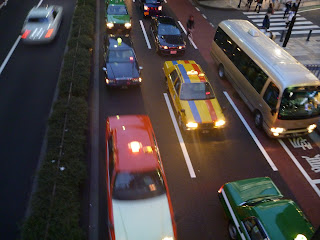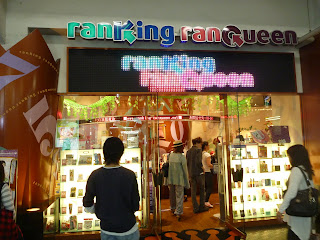The popular usage of subway trains in Japan leads to a less usage of taxis. This doesn’t mean there are less taxis available for this city. Many taxis in Japan can seem like they are creating a higher image for the importance of each client. Automatic doors open up as the passengers are ready to go in are nice gestures and a greater feeling to have when you feel important. The daily starting rate of taxis is 710 yen for the first meter and for every additional meter you’re travelling, 90 yen will be added to the starting rate. This can be quite costly when everything is added up for the people in Japan, even for foreigners. Not only are the rates expensive during the day but it is 20% increase to the daily rate as the night approaches. We should definitely all remember to catch the last train if we can to avoid having to take the taxis at night as much as possible. But if worse does comes, the taxi option will always be at your convenience.

With horror stories that you may have heard about taxis, every taxis company made many aspect safe for the driver and passenger. Some taxis may have security camera installed for passenger’s knowledge in what is going on at the time of their ride. Another safety aspect inside the vehicle is the clear hard divider behind the taxis driver’s seat. This safety feature is mainly for the driver since many cases that happened while driving a drunken passenger home. While interviewing a student on campus, we were told about many cases where drunken passenger would start punching the seats almost causing a disturbance to the driver. Also with no memory from the passenger at times, this can be troublesome for both driver and passenger. It was surprising to hear about no matter how drunk the passenger is they are still a paying costumer. The taxi driver cannot refuse not to take the passenger who’s been drinking. If this was the case back in Calgary, we would be out of luck. There would be no taxis for anyone as the taxi driver usually refuses to take the drunken passenger in the vehicle.

Instead of the little advertisements in the washrooms of pubs, bars and night clubs, there are barely any advertisements for taxi in Tokyo. However, with the flashy color of all the taxis running around in Tokyo, it is really a live advertisement itself. There are so many different colors for Tokyo taxis, there are taxis that are all black, all green or all orange but there are also taxis with a base color such as yellow then have strips or checkered on top of it. Japanese taxi are really clean on the outside, in the three weeks time in Japan, I have yet to see a taxi with advertisements on the body of the car. On the taxi car body there are normally just the company name and company logo that the taxi is belonging to and the radio station that the driver is using to communicate. Most of the taxis also have the no smoking sign and some taxis even have the handicap logo indicating that they are handicap friendly.
With the high expense  of taxi rides, different taxi companies offer different kinds of payment methods to try to be as convenient to the passengers as possible. Every taxi accepts the most basic payment, Japanese yen, and most of the taxis accept credit cards from major banks and Japanese local banks and also checks. Some companies even have the machines that allow the travelers to pay the fee by Suica or Pasmo. This is especially convenient for those people who doesn’t carry large amount of cash and doesn’t have a credit card. Other than Suica and Pasmo, some taxis also accept train cards from other part of Japan, such as ICOCA, TOICA and Nimoca and other electronic money. It is very convenient for those people from other part of the country coming to Tokyo for a short visit. They do not have to get a new card just for a couple of days and study the complicated train lines. Just hop on taxis that accept electronic money, then they can use the card that they already have. To use these cards on taxis are very easy, passengers doesn’t even have to take the cards out of their wallet, they just have to swipe their wallet on the machines like they usually do when entering a station to take a train.
of taxi rides, different taxi companies offer different kinds of payment methods to try to be as convenient to the passengers as possible. Every taxi accepts the most basic payment, Japanese yen, and most of the taxis accept credit cards from major banks and Japanese local banks and also checks. Some companies even have the machines that allow the travelers to pay the fee by Suica or Pasmo. This is especially convenient for those people who doesn’t carry large amount of cash and doesn’t have a credit card. Other than Suica and Pasmo, some taxis also accept train cards from other part of Japan, such as ICOCA, TOICA and Nimoca and other electronic money. It is very convenient for those people from other part of the country coming to Tokyo for a short visit. They do not have to get a new card just for a couple of days and study the complicated train lines. Just hop on taxis that accept electronic money, then they can use the card that they already have. To use these cards on taxis are very easy, passengers doesn’t even have to take the cards out of their wallet, they just have to swipe their wallet on the machines like they usually do when entering a station to take a train.


 If you have a Suica or Passmo card with money already loaded in it, then you don’t have to worry about calculating the costs until you are almost out of money. With the Suica card, you can just swipe it over a sensor at the entrance gate and your fare will be calculated for you.
If you have a Suica or Passmo card with money already loaded in it, then you don’t have to worry about calculating the costs until you are almost out of money. With the Suica card, you can just swipe it over a sensor at the entrance gate and your fare will be calculated for you. As a female getting ready to ride the train, many things came across the mind. Looking around the surroundings, there are many males who would also be riding the same cart of the train. While waiting for the next train, there are males beside you, up front and even behind. In the female’s mind, most males are potential “chikan”. What to do in this situation? The many incidents that occurred before, lead to the actions of getting a “Women’s Only” cart during the morning peak hours which are displayed in the cars. There is no difference in the appearance of the “Women’s Only” cart and the regular carts. The way to identify the cart is the pink signage posted on the inside of the cart.
As a female getting ready to ride the train, many things came across the mind. Looking around the surroundings, there are many males who would also be riding the same cart of the train. While waiting for the next train, there are males beside you, up front and even behind. In the female’s mind, most males are potential “chikan”. What to do in this situation? The many incidents that occurred before, lead to the actions of getting a “Women’s Only” cart during the morning peak hours which are displayed in the cars. There is no difference in the appearance of the “Women’s Only” cart and the regular carts. The way to identify the cart is the pink signage posted on the inside of the cart.
 Before even entering the train, there is proper etiquette to lining up and boarding the train. There are lines painted on the ground, showing people where to line up and how many lines to make. This is extremely helpful, as it prevents people who come later from pushing in front of people who had been waiting for a while. When the train arrives, the doors stop right in front of the lines, once again preventing people from pushing their way to the front.
Before even entering the train, there is proper etiquette to lining up and boarding the train. There are lines painted on the ground, showing people where to line up and how many lines to make. This is extremely helpful, as it prevents people who come later from pushing in front of people who had been waiting for a while. When the train arrives, the doors stop right in front of the lines, once again preventing people from pushing their way to the front. In addition, Japan also has seating specifically designated for priority seating. This includes people with small children or who are pregnant, elderly or disabled passengers. Although you are expected to give your seat to any of these passengers, these seats are especially handy because the people who sit there expect to give their seats away.
In addition, Japan also has seating specifically designated for priority seating. This includes people with small children or who are pregnant, elderly or disabled passengers. Although you are expected to give your seat to any of these passengers, these seats are especially handy because the people who sit there expect to give their seats away. However, many of Japan’s “train etiquettes” are similar to what’s expected in Calgary. If you have a back pack with you, you’re expected to hold it in your lap or place it on a rack. You are supposed to sit close enough to the people beside you to allow the maximum amount of people to sit, and if someone who needs a seat gets on the train, you are expected to give up your seat.
However, many of Japan’s “train etiquettes” are similar to what’s expected in Calgary. If you have a back pack with you, you’re expected to hold it in your lap or place it on a rack. You are supposed to sit close enough to the people beside you to allow the maximum amount of people to sit, and if someone who needs a seat gets on the train, you are expected to give up your seat. Although it may be difficult for a person in a wheel chair to ride the train during rush hour, there are practices in place to help those who may have disabilities. Some of the signs are accompanied with Braille and there is priority seating reserved for those who need to sit. Accompanying the electronic signs announcing the next stop, announcements are made over a loud system.
Although it may be difficult for a person in a wheel chair to ride the train during rush hour, there are practices in place to help those who may have disabilities. Some of the signs are accompanied with Braille and there is priority seating reserved for those who need to sit. Accompanying the electronic signs announcing the next stop, announcements are made over a loud system.














